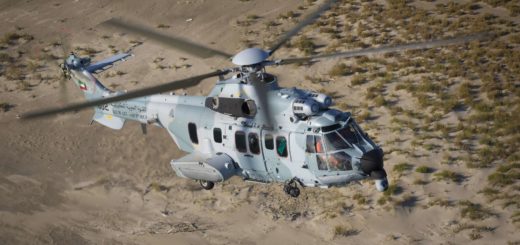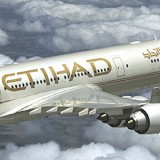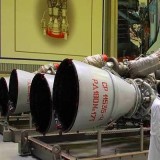U.S. Air Force Validates New MH-139 Grey Wolf Helicopter for ICBM Missile Convoy Protection

{loadposition bannertop}
{loadposition sidebarpub}
The U.S. Air Force marked a significant milestone in its nuclear modernization efforts with the completion of the 2025 Nuclear Convoy Course (NCC), held from March 30 to April 18, 2025, at Camp Guernsey Joint Training Center, Wyoming, United States. This year’s NCC was particularly critical as it played a central role in validating the MH-139 Grey Wolf helicopter, a next-generation asset designed to bolster the security and efficiency of transporting InterContinental Ballistic Missile (ICBM) components.Follow Army Recognition on Google News at this link
The MH-139 Grey Wolf helicopter during recent U.S. Air Force training operations. (Picture source: U.S. Air Force)
The NCC (Nuclear Convoy Course), directed by the 20th Air Force and organized by the 90th Ground Combat Training Squadron, is a premier training event that tests the readiness of Convoy Response Forces (CRF) through threat-based, full mission profile exercises. This year’s training brought together CRF units from the 90th Missile Security Operations Squadron at F.E. Warren Air Force Base in Wyoming, the 91st at Minot AFB in North Dakota, and the 341st at Malmstrom AFB in Montana. These units trained extensively to protect high-value assets during off-installation convoys, integrating for the first time with the MH-139 Grey Wolf and the new Payload Transporter Replacement vehicle (PTR).
According to Master Sgt. Kevin Brown, training and force development manager with the Air Force Global Strike Command Operations and Plans Directorate, this year’s NCC was strategically aligned with Air Force Global Strike Command’s vision to modernize the nuclear enterprise. “This year’s NCC is critical in validating the MH-139 Grey Wolf and the Payload Transporter replacement vehicle. These new assets bring a much-needed refresh to the mission of providing security and safe transport for ICBMs off installation as part of the modernization of nuclear systems as outlined by Gen. Bussiere’s strategic vision,” said Brown.
The introduction of the MH-139 Grey Wolf—designed to replace the aging UH-1N Huey fleet—marks a leap forward in mission capability, offering improved speed, range, and survivability. During NCC, this new helicopter was integrated into convoy operations to test its operational effectiveness in real-world scenarios. To ensure seamless adoption, new Tactics, Techniques and Procedures (TTPs) developed specifically for the MH-139 and PTR were tested and standardized across all three missile wings participating in the training.
Adding further realism to the training, Soldiers from the U.S. Army’s 101st Airborne Division (Air Assault) served as the opposing force (OPFOR), engaging CRF units in simulated ambushes and asymmetric threats. These scenarios challenged the CRF to defend their convoys using the new equipment and protocols under combat-like conditions. First Lt. Luke Davey, scout platoon leader with the 101st, noted the mutual benefit of the exercise: “Fighting as OPFOR for this training event has greatly enhanced our own capabilities. It’s given us a great understanding of militia and paramilitary ambushes and how small elements can fight off larger enemies.”
For the defenders, the training not only validated the MH-139 but also highlighted operational gaps and areas for improvement. “The Nuclear Convoy Course enhances our defenders by giving us a clearer understanding of what real-world threats look like,” said Master Sgt. Charles Watson, convoy response force flight chief with the 90th Missile Security Operations Squadron. “Training with the forces here allows us to evaluate how effective our TTPs are and identify areas we need to improve when we return to home station.”
Camp Guernsey’s diverse training terrain enabled a wide range of operational scenarios not typically available at home installations. This allowed CRF teams to refine their response capabilities and adapt to evolving threat environments.
With the successful completion of the 2025 NCC and the MH-139 Grey Wolf’s performance validated under demanding conditions, the U.S. Air Force takes a significant step forward in modernizing its strategic deterrent. Looking ahead, the upcoming Advanced Recapture Recovery Operational Warfighter (ARROW) exercise will continue to build on the momentum, ensuring the nuclear enterprise remains secure, agile, and ready to meet any challenge.
The MH-139 Grey Wolf, developed by Boeing in partnership with Leonardo, is based on the AW139 platform and tailored to meet the U.S. Air Force’s specific requirements. It offers significantly improved performance characteristics over the legacy UH-1N Huey fleet, including higher speed, extended range, and a greater payload capacity. These improvements allow the MH-139 to conduct missions faster and more efficiently while enhancing operational coverage.
In terms of survivability, the MH-139 incorporates advanced ballistic protection, a crashworthy airframe, and energy-absorbing seats to protect crew and passengers in hostile environments. Its integrated avionics suite provides advanced navigation, situational awareness, and communication capabilities, crucial for coordinating complex security missions in dynamic operational theaters.
The helicopter is designed for multiple roles critical to national defense, including ICBM field security patrols, transport of personnel and cargo, search and rescue operations, and VIP transportation. Each of these missions is essential to maintaining the responsiveness and resilience of the Air Force’s strategic deterrence mission.
Initial procurement plans called for up to 84 MH-139 helicopters, although recent adjustments due to budgetary constraints have influenced delivery timelines and fleet size. As of 2025, several units have been delivered and are undergoing phased operational integration into key missile security squadrons.
The successful deployment and validation of the MH-139 Grey Wolf during NCC 2025 reaffirm the Air Force’s commitment to a modern, secure, and efficient nuclear command and control infrastructure. With its advanced capabilities, the Grey Wolf is set to become a cornerstone of the nation’s strategic defense posture for years to come.

{loadposition bannertop}
{loadposition sidebarpub}
The U.S. Air Force marked a significant milestone in its nuclear modernization efforts with the completion of the 2025 Nuclear Convoy Course (NCC), held from March 30 to April 18, 2025, at Camp Guernsey Joint Training Center, Wyoming, United States. This year’s NCC was particularly critical as it played a central role in validating the MH-139 Grey Wolf helicopter, a next-generation asset designed to bolster the security and efficiency of transporting InterContinental Ballistic Missile (ICBM) components.
Follow Army Recognition on Google News at this link
The MH-139 Grey Wolf helicopter during recent U.S. Air Force training operations. (Picture source: U.S. Air Force)
The NCC (Nuclear Convoy Course), directed by the 20th Air Force and organized by the 90th Ground Combat Training Squadron, is a premier training event that tests the readiness of Convoy Response Forces (CRF) through threat-based, full mission profile exercises. This year’s training brought together CRF units from the 90th Missile Security Operations Squadron at F.E. Warren Air Force Base in Wyoming, the 91st at Minot AFB in North Dakota, and the 341st at Malmstrom AFB in Montana. These units trained extensively to protect high-value assets during off-installation convoys, integrating for the first time with the MH-139 Grey Wolf and the new Payload Transporter Replacement vehicle (PTR).
According to Master Sgt. Kevin Brown, training and force development manager with the Air Force Global Strike Command Operations and Plans Directorate, this year’s NCC was strategically aligned with Air Force Global Strike Command’s vision to modernize the nuclear enterprise. “This year’s NCC is critical in validating the MH-139 Grey Wolf and the Payload Transporter replacement vehicle. These new assets bring a much-needed refresh to the mission of providing security and safe transport for ICBMs off installation as part of the modernization of nuclear systems as outlined by Gen. Bussiere’s strategic vision,” said Brown.
The introduction of the MH-139 Grey Wolf—designed to replace the aging UH-1N Huey fleet—marks a leap forward in mission capability, offering improved speed, range, and survivability. During NCC, this new helicopter was integrated into convoy operations to test its operational effectiveness in real-world scenarios. To ensure seamless adoption, new Tactics, Techniques and Procedures (TTPs) developed specifically for the MH-139 and PTR were tested and standardized across all three missile wings participating in the training.
Adding further realism to the training, Soldiers from the U.S. Army’s 101st Airborne Division (Air Assault) served as the opposing force (OPFOR), engaging CRF units in simulated ambushes and asymmetric threats. These scenarios challenged the CRF to defend their convoys using the new equipment and protocols under combat-like conditions. First Lt. Luke Davey, scout platoon leader with the 101st, noted the mutual benefit of the exercise: “Fighting as OPFOR for this training event has greatly enhanced our own capabilities. It’s given us a great understanding of militia and paramilitary ambushes and how small elements can fight off larger enemies.”
For the defenders, the training not only validated the MH-139 but also highlighted operational gaps and areas for improvement. “The Nuclear Convoy Course enhances our defenders by giving us a clearer understanding of what real-world threats look like,” said Master Sgt. Charles Watson, convoy response force flight chief with the 90th Missile Security Operations Squadron. “Training with the forces here allows us to evaluate how effective our TTPs are and identify areas we need to improve when we return to home station.”
Camp Guernsey’s diverse training terrain enabled a wide range of operational scenarios not typically available at home installations. This allowed CRF teams to refine their response capabilities and adapt to evolving threat environments.
With the successful completion of the 2025 NCC and the MH-139 Grey Wolf’s performance validated under demanding conditions, the U.S. Air Force takes a significant step forward in modernizing its strategic deterrent. Looking ahead, the upcoming Advanced Recapture Recovery Operational Warfighter (ARROW) exercise will continue to build on the momentum, ensuring the nuclear enterprise remains secure, agile, and ready to meet any challenge.
The MH-139 Grey Wolf, developed by Boeing in partnership with Leonardo, is based on the AW139 platform and tailored to meet the U.S. Air Force’s specific requirements. It offers significantly improved performance characteristics over the legacy UH-1N Huey fleet, including higher speed, extended range, and a greater payload capacity. These improvements allow the MH-139 to conduct missions faster and more efficiently while enhancing operational coverage.
In terms of survivability, the MH-139 incorporates advanced ballistic protection, a crashworthy airframe, and energy-absorbing seats to protect crew and passengers in hostile environments. Its integrated avionics suite provides advanced navigation, situational awareness, and communication capabilities, crucial for coordinating complex security missions in dynamic operational theaters.
The helicopter is designed for multiple roles critical to national defense, including ICBM field security patrols, transport of personnel and cargo, search and rescue operations, and VIP transportation. Each of these missions is essential to maintaining the responsiveness and resilience of the Air Force’s strategic deterrence mission.
Initial procurement plans called for up to 84 MH-139 helicopters, although recent adjustments due to budgetary constraints have influenced delivery timelines and fleet size. As of 2025, several units have been delivered and are undergoing phased operational integration into key missile security squadrons.
The successful deployment and validation of the MH-139 Grey Wolf during NCC 2025 reaffirm the Air Force’s commitment to a modern, secure, and efficient nuclear command and control infrastructure. With its advanced capabilities, the Grey Wolf is set to become a cornerstone of the nation’s strategic defense posture for years to come.





